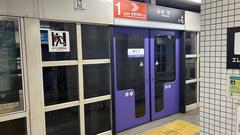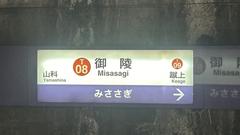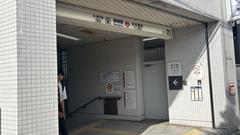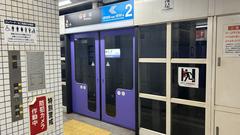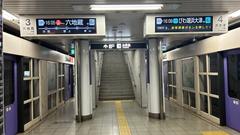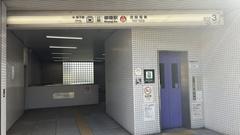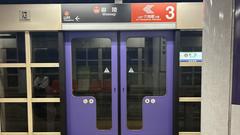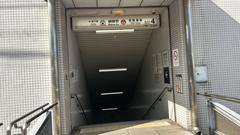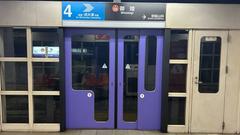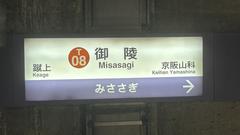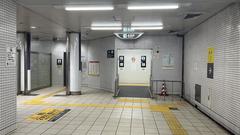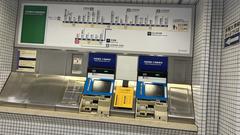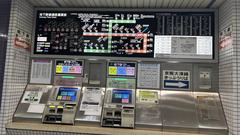
Misasagi Station Kyoto: Visiting Hours, Tickets, and Tourist Guide
Date: 14/06/2025
Introduction
Misasagi Station (御陵駅), located in Kyoto’s tranquil Yamashina district, is both a vital modern transit hub and a gateway to some of the city’s most significant historical and cultural sites. Its name, “Misasagi,” meaning imperial tomb or mausoleum, directly references its proximity to the Imperial Tomb of Emperor Tenji. Since opening in 1912, the station has grown from a simple railway stop into a major interchange between the Kyoto Municipal Subway Tōzai Line and the Keihan Keishin Line. This guide provides detailed visitor information including practical travel tips, ticketing options, accessibility, and nearby attractions, helping you enjoy a seamless and enriching Kyoto experience (Keihan Railway, Kyoto Municipal Subway, Japan Travel).
Historical Background
Origins and Etymology
The station’s name, “Misasagi,” is a direct nod to the imperial tombs (misasagi) nearby, most notably that of Emperor Tenji, which lies just north of the station. The Yamashina district itself historically served as a crossroads for travelers and officials moving between Kyoto and Nara, making it a site of cultural and political importance for centuries.
Railway Development
Misasagi Station opened on August 15, 1912, as part of the Keishin Denki Kido railway. After joining the Keihan Electric Railway in 1925, it underwent significant changes during the mid-20th century, especially with the introduction of the Kyoto Municipal Subway Tozai Line in 1997, turning it into a modern underground interchange.
Visiting Misasagi Station: Practical Information
Station Hours
Misasagi Station generally operates from 5:30 AM to midnight, accommodating both the subway and Keihan lines. Exact train departure and arrival times may vary, so check the latest schedules on official websites prior to your visit.
Tickets and Fare Options
Tickets can be purchased at multilingual machines or staffed counters. The PiTaPa smart card system, as well as national IC cards like ICOCA and Suica, are supported for hassle-free travel. Tourists may benefit from the Kyoto Sightseeing Pass, which covers both subway and bus routes, including those serving Misasagi Station.
Access and Connectivity
Located in Yamashina Ward, Misasagi Station is easily reached from central Kyoto via the Tozai Line (station code T08) or Keihan Keishin Line. Several city bus routes also serve the area, providing connections to other districts and historical sites.
Accessibility and Facilities
The station features elevators, escalators, tactile paving, and barrier-free pathways for passengers with mobility needs. Clean restrooms and helpful staff are available. Real-time train status displays keep travelers informed.
Nearby Attractions and Historical Sites
Imperial Tombs
The Imperial Tomb of Emperor Tenji, the oldest in Kyoto, is a short walk from the station. Other prominent tombs in the area include those of Emperor Daigo and the famed shogun Sakanoue no Tamuramaro. These sacred sites offer tranquil settings for reflection and photography.
Traditional Pottery District
Yamashina is home to the Kiyomizuyaki Danchi, a pottery district with a rich legacy dating back to the 15th century. Here, visitors can browse shops selling Kiyomizuyaki ceramics and, in October, enjoy the Kiyomizuyaki no Sato Matsuri pottery festival.
Yamashina Canal
Constructed during the Meiji era, the Yamashina Canal is lined with cherry blossoms in spring and vivid foliage in autumn. Sightseeing boat rides operate seasonally, providing a peaceful perspective on local history and scenery (Kyoto Travel).
Temples and Shrines
Nearby religious sites include Kaju-ji Temple, renowned for its gardens and imperial connections, as well as Anraku-ji and Konkaikomyo-ji, which offer a quieter spiritual experience away from the main tourist crowds.
Shogunzuka Seiryu-den
A short journey from the station leads to the Shogunzuka Mound and Seiryu-den, which grants panoramic views of Kyoto and hosts seasonal cultural events.
Local Life and Amenities
The area around Misasagi Station is primarily residential, with a mix of traditional machiya houses, cozy family-run eateries, bakeries, and convenience stores. While not a commercial hotspot, it provides an authentic atmosphere and a glimpse into everyday Kyoto life.
For shopping and additional amenities, head to the nearby Yamashina Station area, which boasts larger retail outlets and department stores (Living Nomads).
Events and Cultural Experiences
The station serves as a convenient base for attending citywide festivals, such as the Gozan no Okuribi (Daimonji Bonfire) during Obon, and for enjoying hanami (cherry blossom viewing) and momiji-gari (autumn leaf viewing) in local parks and temple grounds. Pottery festivals and occasional guided tours of the tombs and temples are also available (Kyoto City Yamashina Tourist Map, PDF).
Traveler Tips
- Timing: Visit during weekday mornings for a peaceful experience. Spring and autumn are particularly scenic.
- Etiquette: Maintain respectful behavior at imperial tombs and religious sites.
- Accessibility: The station and many nearby sites are fully accessible for travelers with disabilities.
- Tickets: Utilize IC cards or sightseeing passes for convenience and savings.
- Tourist Info: Multilingual signage and tourist support desks are available within the station.
Visual and Media Recommendations
For a richer experience, explore official Kyoto tourism websites for maps and virtual tours. Recommended imagery includes:
- The modern entrance of Misasagi Station (alt: “Misasagi Station entrance in Kyoto”).
- Imperial Tomb of Emperor Tenji (alt: “Imperial Tomb of Emperor Tenji near Misasagi Station”).
- Kiyomizuyaki pottery shops and festival scenes (alt: “Kiyomizuyaki pottery near Misasagi”).
- Yamashina Canal in spring (alt: “Cherry blossoms along Yamashina Canal in Kyoto’s Yamashina area”).
Frequently Asked Questions (FAQ)
Q: What are the visiting hours of Misasagi Station?
A: The station is open daily from 5:30 AM to midnight.
Q: How can I buy tickets?
A: Use ticket machines, staffed counters, or IC cards like ICOCA, Suica, and PiTaPa.
Q: Which historical sites are nearby?
A: The Imperial Tomb of Emperor Tenji, Yamashina Canal, and Kiyomizuyaki pottery district.
Q: Are there guided tours?
A: Yes, especially during festivals and cherry blossom/autumn foliage seasons; check with local tourism offices.
Q: Is the station accessible for disabled travelers?
A: Yes, elevators, ramps, and tactile paths are provided.
Summary Table: Key Historical Milestones
| Year | Event |
|---|---|
| 1912 | Opened as Keishin Denki Kido station |
| 1925 | Became part of Keihan Electric Railway |
| 1943 | Managed by Keihanshin Express Railway |
| 1949 | Returned to Keihan Electric Railway |
| 1997 | Subway Tozai Line underground station opened |
| 2007 | PiTaPa smart card system introduced |
Conclusion
Misasagi Station is more than a transit point—it’s a portal into Kyoto’s imperial past and vibrant cultural present. With comprehensive transit options, user-friendly facilities, and access to some of the city’s most serene and storied sites, it’s ideal for travelers seeking both convenience and authenticity. Use this guide to plan your visit, take advantage of sightseeing passes, and explore the lesser-known treasures of Yamashina and beyond. For updated information and audio tours, download the Audiala app and explore our other Kyoto travel resources.
Sources
- Official Keihan Railway Website
- Japan Travel: Misasagi and Yamashina Area
- Kyoto Municipal Subway Tozai Line Information
- Kyoto Travel: Yamashina Canal
- Kyoto Travel: General Information
- Kyoto City Yamashina Tourist Map, PDF
- Audiala Mobile App Download
- W Magazine Kyoto Guide
- Living Nomads Kyoto Travel Tips
- Welcome to Kyoto
- Mapcarta: Honkoku-ji Temple


